
(Download a higher resolution picture by clicking on any
picture below.) 
I toured the U.S. Naval Museum of Armament & Technology at China Lake NAWS on June 25, 2002. It houses an extensive collection of missiles and weapons delivery systems.
(Please note: the Goleta Air & Space Museum is not directly affiliated with the U.S. Naval Museum of Armament & Technology. I cannot arrange access to the museum or get you onto China Lake NAWS. Visit the U.S. Naval Museum of Armament & Technology web site for information about visiting the museum.)
The second prototype Douglas XF4D-1 Skyray, BuNo 124587; a Polaris missile; and the second (of only two) Grumman F11F-1F Super Tiger, 138647 flank a Polaris missile across the parking lot from the entrance to the U.S. Naval Museum of Armament & Technology.
Navair Public Affairs announcement of the opening of the U.S. Naval Museum of Armament & Technology.
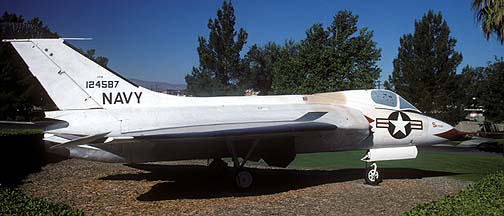 Douglas XF4D-1, 124587 is the second prototype
of the Skyray. It was delivered with an interim 5,000-pound
thrust J35-A-17 turbojet until the intended 7,000-pound thrust
XJ40-WE-6 became available. That was followed by an 11,600-pound
thrust afterburning XJ40-WE-8. Production models of the Skyray
were equipped with J57 turbojets. XF4D-1, 124587 was used as an
engine testbed by General Electric, testing the J79 and CJ805-3
engine intended for the Convair 880.
Douglas XF4D-1, 124587 is the second prototype
of the Skyray. It was delivered with an interim 5,000-pound
thrust J35-A-17 turbojet until the intended 7,000-pound thrust
XJ40-WE-6 became available. That was followed by an 11,600-pound
thrust afterburning XJ40-WE-8. Production models of the Skyray
were equipped with J57 turbojets. XF4D-1, 124587 was used as an
engine testbed by General Electric, testing the J79 and CJ805-3
engine intended for the Convair 880.
Piloted by Navy Lt-Cdr James B. Verdin, XF4D-1, 124587 set a new world's air speed record of 752.944 mph over a three-kilometer course above the Salton Sea in California on October 3, 1953, breaking a record speed of 735.70 mph set by Michael J. Lithgow in a Supermarine Swift F Mk4 just nine days earlier at Castel Idris, Libya. Lt-Cdr Verdin's record was beaten twenty-six days later by Frank Everest in a North American YF-100A at the Salton Sea in southern California. Everest's speed record was just 2.20 mph faster than Verdin's.
XF4D-1, 124587 was unpainted and sat among a
large collection of retired airplanes on April 16, 1988. 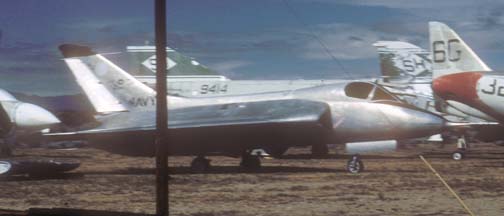
History of the XF4D-1 on Air-Navy.com.
Aviation Enthusiast Corner's list of F-6 (F4D) Skyrays on display.
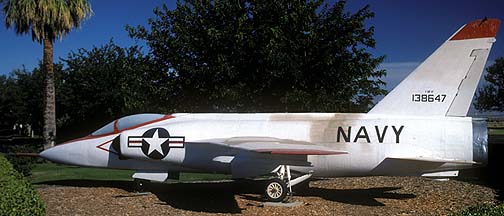 F11F-1F, 138647 is the only surviving Super
Tiger. Two F11F-1F Super Tigers were constructed with 15,000-lb
thrust General Electric YJ79-GE-3A engines in place of the
10,500-lb thrust Westinghouse J65-W-18 that equipped the standard
F11F-1 Tiger. Grumman test pilot John Norris achieved a speed of
Mach 2.04 in 138647 on May 2, 1957. Piloted by Lt-Cdr George
Watkins, 138647 set an altitude record of 76,831 feet over
Edwards AFB on April 16, 1958.
F11F-1F, 138647 is the only surviving Super
Tiger. Two F11F-1F Super Tigers were constructed with 15,000-lb
thrust General Electric YJ79-GE-3A engines in place of the
10,500-lb thrust Westinghouse J65-W-18 that equipped the standard
F11F-1 Tiger. Grumman test pilot John Norris achieved a speed of
Mach 2.04 in 138647 on May 2, 1957. Piloted by Lt-Cdr George
Watkins, 138647 set an altitude record of 76,831 feet over
Edwards AFB on April 16, 1958.
Aviation Enthusiast Corner's list of F11F Tigers on display.
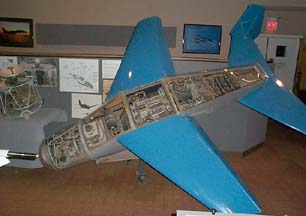 ASM-2 Bat radar-guided glide bomb was originally carried by
Consolidated PB4Y-2 Privateers. It carries an active S-band radar
transmitter to track the target, allowing the launch plane to
take evasive action after launch. This is the only Bat with the
avionics intact, displayed under clear plexiglas.
ASM-2 Bat radar-guided glide bomb was originally carried by
Consolidated PB4Y-2 Privateers. It carries an active S-band radar
transmitter to track the target, allowing the launch plane to
take evasive action after launch. This is the only Bat with the
avionics intact, displayed under clear plexiglas.
There is another Bat Missile at the National Institute of Standards and Technology Museum in Gaithersburg, Maryland.
The National Air & Space Museum also has a Bat.
More information about the Bat Glide Bomb is available on Bathead's web site.
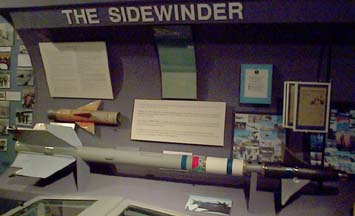 The
infra-red guided AIM-9 Sidewinder was developed fifty years ago
by the Naval Ordnance Test Station. Sidewinders are used at
relatively short range.
The
infra-red guided AIM-9 Sidewinder was developed fifty years ago
by the Naval Ordnance Test Station. Sidewinders are used at
relatively short range.
U. S. Navy Fact File for the AIM-9 Sidewinder.
Federation of American Scientists page about the AIM-9 Sidewinder.
Raytheon's page about the AIM-9 Sidewinder.
Directory of U. S. Military Rockets and Missiles page about the AIM-9 Sidewinder.
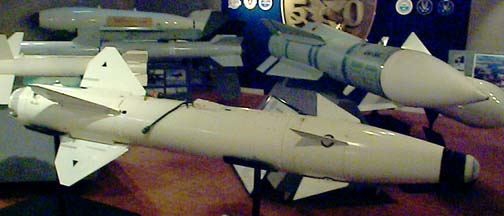 AGM-12 Bullpup
radio-guided air-to-ground missile and AIM-54 Phoenix long range,
active, radar-guided air-to-air missile.
AGM-12 Bullpup
radio-guided air-to-ground missile and AIM-54 Phoenix long range,
active, radar-guided air-to-air missile.
The AGM-12 Bullpup was equipped with flares to allow the pilot of the attacking airplane to track it visually. The pilot had to follow the missile directly toward the target, feeding it course corrections by radio, until it impacted.
Federation of American Scientists page about the AGM-12 Bullpup.
Directory of U. S. Military Rockets and Missiles page about the AGM-12 Bullpup.
The AIM-54 Phoenix carries its own radar transmitter for tracking its target. It has a range of over 100 miles and flies faster than a Lockheed SR-71A Blackbird.
Federation of American Scientists page about the AIM-54 Phoenix.
Raytheon's page about the AIM-54 Phoenix.
Navy Fact File about the AIM-54 Phoenix.
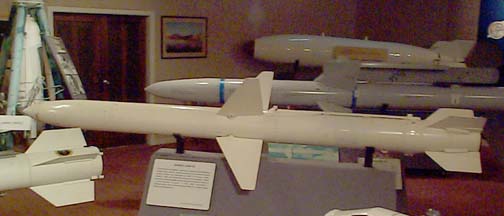 AGM-45 Shrike
anti-radar missiles were carried by Republic F-105G Wild Weasels,
McDonnell-Douglas F-4G Wild Weasels, Grumman EA-6A Prowlers, and Vought A-7 Corsairs. The AGM-45 Shrike
was based on the Sparrow radar-guided, air-to-air missile. If the
targeted enemy radar shut down, it was unable to continue
tracking the target.
AGM-45 Shrike
anti-radar missiles were carried by Republic F-105G Wild Weasels,
McDonnell-Douglas F-4G Wild Weasels, Grumman EA-6A Prowlers, and Vought A-7 Corsairs. The AGM-45 Shrike
was based on the Sparrow radar-guided, air-to-air missile. If the
targeted enemy radar shut down, it was unable to continue
tracking the target.
Federation of American Scientists page about the AGM-45 Shrike.
Directory of U. S. Military Rockets and Missiles page about the AGM-45.
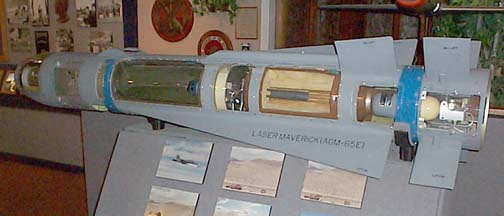 AGM-65E Laser Maverick required the attacking airplane to
designate the target until impact.
AGM-65E Laser Maverick required the attacking airplane to
designate the target until impact.
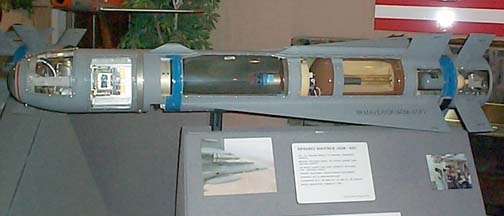 AGM-65F Infra-red Maverick is a fire-and-forget missile, tracking
the target independently after launch.
AGM-65F Infra-red Maverick is a fire-and-forget missile, tracking
the target independently after launch.
Federation of American Scientists page about the AGM-65 Maverick.
Air Force Fact Sheet about the AGM-65 Maverick.
Navy Fact File about the AGM-65 Maverick.
PMA205 Naval Aviation Training Systems page about the AGM-65 Maverick.
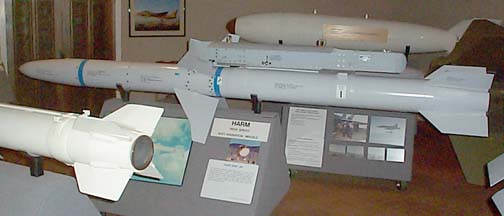 AGM-88 High-speed
Anti-Radiation Missile (HARM) can memorize the location of an
enemy radar transmitter to allow it to continue heading toward
the target even if the radar shuts down.
There is a free-fall atomic bomb next to the wall in the background.
One of the photos below the atomic bomb shows an example being carried
by a Douglas A-1 Skyraider.
AGM-88 High-speed
Anti-Radiation Missile (HARM) can memorize the location of an
enemy radar transmitter to allow it to continue heading toward
the target even if the radar shuts down.
There is a free-fall atomic bomb next to the wall in the background.
One of the photos below the atomic bomb shows an example being carried
by a Douglas A-1 Skyraider.
Directory of U. S. Military Rockets and Missiles page about the AGM-88 HARM.
Federation of American Scientists page about the AGM-88 HARM.
Navy Fact File about the AGM-88 HARM.
PMA205 Naval Aviation Training Systems page about the AGM-88 HARM.
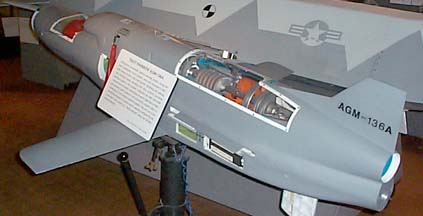 AGM-136A Tacit Rainbow was an ambitious attempt to develop a
loitering, anti-radar cruise missile. The Tacit Rainbow would fly
around the target zone, waiting for enemy anti-aircraft radar to
be turned on. Then it would target and attack the radar
transmitter autonomously.
AGM-136A Tacit Rainbow was an ambitious attempt to develop a
loitering, anti-radar cruise missile. The Tacit Rainbow would fly
around the target zone, waiting for enemy anti-aircraft radar to
be turned on. Then it would target and attack the radar
transmitter autonomously.
Federation of American Scientists page about the AGM-136A Tacit Rainbow.
1989 article from Aerospace Power Journal about how the Tacit Rainbow might have been deployed on Boeing B-52 Stratofortresses.
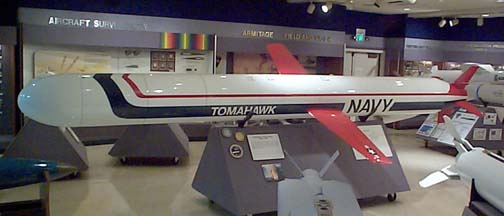 BGM-109
Tomahawk has a range of 1,000 miles with a 1,500-pound warhead.
It uses radar Terrain Contour Matching (Tercom) for mid-course
navigation, matching radar images of the terrain to a digital
terrain model in its memory. It compares a stored digital image
of the target with an image acquired in real time for the
terminal approach to the target.
BGM-109
Tomahawk has a range of 1,000 miles with a 1,500-pound warhead.
It uses radar Terrain Contour Matching (Tercom) for mid-course
navigation, matching radar images of the terrain to a digital
terrain model in its memory. It compares a stored digital image
of the target with an image acquired in real time for the
terminal approach to the target.
Federation of American Scientists page about the BGM-109 Tomahawk.
Navy Fact File about the BGM-109 Tomahawk.
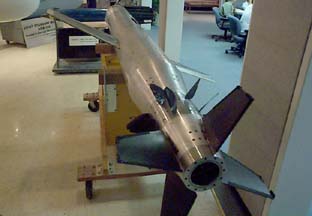 Advanced Cruise Missile proposal
Advanced Cruise Missile proposal
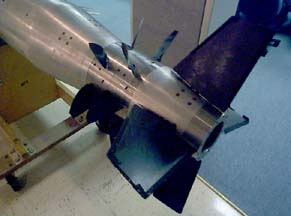 Contra-rotating propellers of Advanced Cruise Missile
Contra-rotating propellers of Advanced Cruise Missile
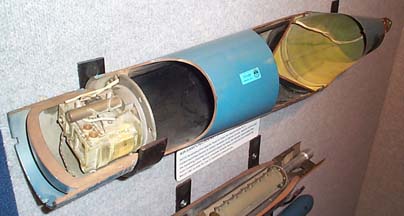 This bunker busting,
shape charge warhead was developed in a hurry during World War
II. Look close and you can see springs from common clothes pins.
This bunker busting,
shape charge warhead was developed in a hurry during World War
II. Look close and you can see springs from common clothes pins.
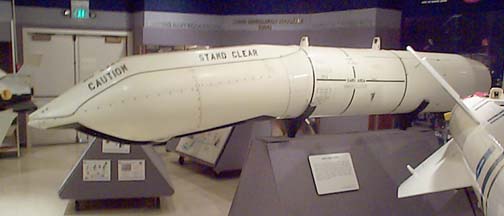 AN/ALQ-10 Pave Knife laser target designator pod was developed by
Aeronutronic-Ford. They were used in combat in Vietnam.
AN/ALQ-10 Pave Knife laser target designator pod was developed by
Aeronutronic-Ford. They were used in combat in Vietnam.
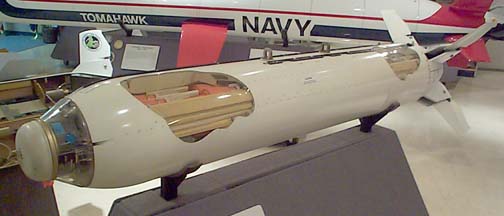 Mk 20
Rockeye II cluster munitions dispenser carries 247 1.32-pound
bomblets. The bomblets incorporate a simple spring loaded
mechanism that can trigger the explosive charge in two ways. If
the minelet strikes a hard object, the shape charge is detonated
to blow a hole through armor. If the minelet does not strike a
hard object, it springs back up into the air and a secondary
trigger detonates the explosive charge to inflict widespread
damage on softer targets.
Mk 20
Rockeye II cluster munitions dispenser carries 247 1.32-pound
bomblets. The bomblets incorporate a simple spring loaded
mechanism that can trigger the explosive charge in two ways. If
the minelet strikes a hard object, the shape charge is detonated
to blow a hole through armor. If the minelet does not strike a
hard object, it springs back up into the air and a secondary
trigger detonates the explosive charge to inflict widespread
damage on softer targets.
Federation of American Scientists page about the Mk 20 Rockeye II.
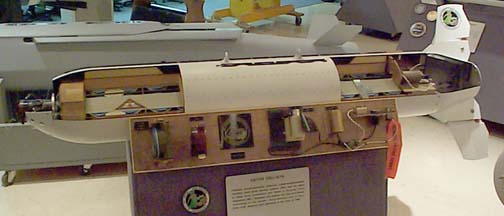 CBU-78 Gator
carries 45 BLU-91/B anti-vehicle and 15 BLU-92/B antipersonnel
land mines.
CBU-78 Gator
carries 45 BLU-91/B anti-vehicle and 15 BLU-92/B antipersonnel
land mines.
Federation of American Scientists page about the CBU-78 Gator.
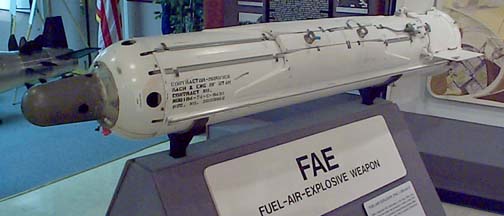 CBU-72 cluster bomb contains three BLU-73 Fuel Air Explosive
submunitions. During Desert Storm, CBU-72s were dropped primarily
from Marine Corps Grumman A-6E Intruders.
CBU-72 cluster bomb contains three BLU-73 Fuel Air Explosive
submunitions. During Desert Storm, CBU-72s were dropped primarily
from Marine Corps Grumman A-6E Intruders.
Federation of American Scientists page about the CBU-72 cluster bomb.
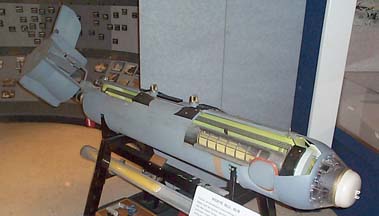 BLU-80/B Bigeye
binary chemical munition dispenser would have carried 180 pounds
of VX nerve agent. .
BLU-80/B Bigeye
binary chemical munition dispenser would have carried 180 pounds
of VX nerve agent. .
Federation of American Scientists page about the BLU-80/B Bigeye.
U.S. Army Soldier and Biological Chemical Command chemical agent fact sheet for VX Nerve Agent.
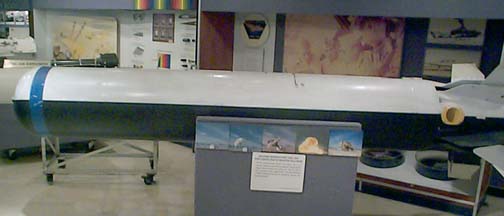 BLU-95/96 Fuel Air Explosive II. BLU-95 is a 500-pound weapon.
BLU-96 weighs 2,000 pounds. They are fueled by ethylene oxide.
BLU-95/96 Fuel Air Explosive II. BLU-95 is a 500-pound weapon.
BLU-96 weighs 2,000 pounds. They are fueled by ethylene oxide.
Federation of American Scientists page about the BLU-95/96 Fuel Air Explosive.
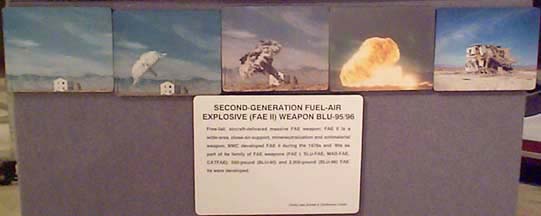 Illustration of the effectiveness of the BLU-95/96 Fuel Air
Explosive
Illustration of the effectiveness of the BLU-95/96 Fuel Air
Explosive
Navair animated .GIF of this fuel air explosion test.
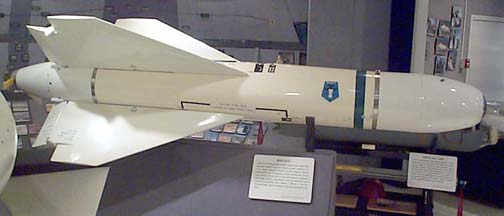 AGM-62 Walleye
II television-guided, glide bomb tracks on a video image of the
target. While very accurate against high contrast targets, the
television guidance system has difficulty with low contrast
targets.
AGM-62 Walleye
II television-guided, glide bomb tracks on a video image of the
target. While very accurate against high contrast targets, the
television guidance system has difficulty with low contrast
targets.
Directory of U. S. Military Rockets and Missiles page about the AGM-62 Walleye.
Federation of American Scientists page about the AGM-62 Walleye.
PMA205 Naval Aviation Training Systems page about the AGM-62 Walleye.
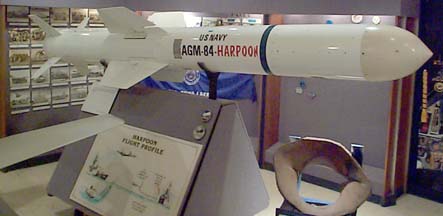 AGM-84 Harpoon
anti-shipping missile uses inertial navigation to approach its
target. Once near the target it uses radar to acquire and attack
the target. It has a range of over 60 miles.
AGM-84 Harpoon
anti-shipping missile uses inertial navigation to approach its
target. Once near the target it uses radar to acquire and attack
the target. It has a range of over 60 miles.
Navy Fact File about the AGM-84 Harpoon.
PMA205 Naval Aviation Training Systems page about the AGM-84 Harpoon.
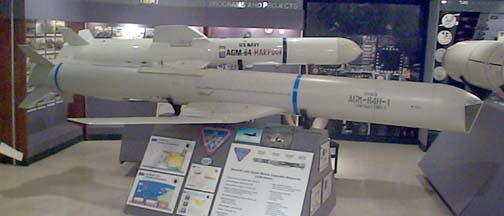 AGM-84H Standoff
Land Attack Missile-Expanded Response (SLAM-ER) was developed
from the Harpoon and has a range of over 150 miles. The
television seeker of the AGM-84H SLAM-ER allows the pilot of the
attacking airplane to guide the missile prior to impact or to
revise the aim point after launch.
AGM-84H Standoff
Land Attack Missile-Expanded Response (SLAM-ER) was developed
from the Harpoon and has a range of over 150 miles. The
television seeker of the AGM-84H SLAM-ER allows the pilot of the
attacking airplane to guide the missile prior to impact or to
revise the aim point after launch.
Federation of American Scientists page about the AGM-84 Harpoon and SLAM.
PMA205 Naval Aviation Training Systems page about the AGM-84H SLAM-ER.
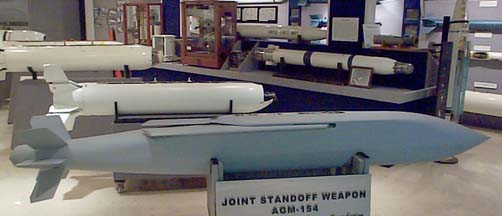 AGM-154 Joint Standoff Weapon (JSOW) is a glide weapon with GPS
and inertial guidance. Terminal guidance to the target is
accomplished by imaging infra-red through a datalink.
AGM-154 Joint Standoff Weapon (JSOW) is a glide weapon with GPS
and inertial guidance. Terminal guidance to the target is
accomplished by imaging infra-red through a datalink.
Federation of American Scientists page about the AGM-154 JSOW.
PMA205 Naval Aviation Training Systems page about the AGM-154 JSOW.
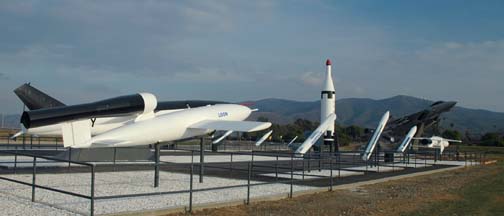 The Point Mugu Naval Air Station is home to the Pt. Mugu Missile Park. There
you can see a wide variety of the missiles and airplanes that have been tested at Point Mugu since World War II.
The Point Mugu Naval Air Station is home to the Pt. Mugu Missile Park. There
you can see a wide variety of the missiles and airplanes that have been tested at Point Mugu since World War II.
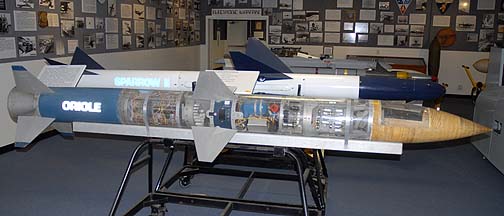 The Naval Air Warfare Center Weapons Division Archive Center located at the Naval Base Ventura County, Point Mugu is home to a large collection of air-to-air and air-to-surface missiles and electronics countermeasures equipment. It is open to the public from 10:00 AM to 3:00 PM each Wednesday. It is located in Building 112, just outside the main gate.
The Naval Air Warfare Center Weapons Division Archive Center located at the Naval Base Ventura County, Point Mugu is home to a large collection of air-to-air and air-to-surface missiles and electronics countermeasures equipment. It is open to the public from 10:00 AM to 3:00 PM each Wednesday. It is located in Building 112, just outside the main gate.
 Go to the main China Lake NAWS tour page.
Go to the main China Lake NAWS tour page.
Go to home page of the Goleta Air and Space Museum.
Send a message to Brian.